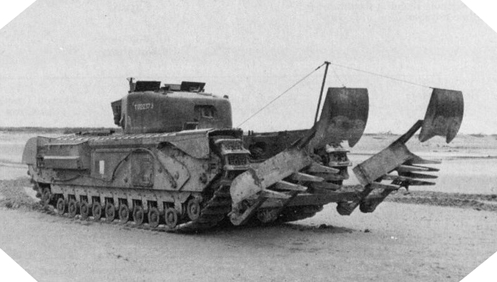Bullshorn Plough tank
History, technical sheet and photo

Bullshorn Plough tank history
To support the infantry through the minefields and the various obstacles in the field of operations in Europe and the Pacific, the Allied military engineers decided to add to some of their tanks a new system devised by the military engineer Percy Hobart.
Thus, the version “Bullshorn Plow” is born. It is a demining model that, like the Crab tank, has a real plow that digs the ground and clears the mines outward without causing them to explode. Once the mines are cleared, they must be disarmed by the sappers.
This flail system also adapts to the chassis of the British Churchill tank (model whose characteristics are presented here) and to the American Sherman tank.
This tank “Bullshorn Plow” is one of the “funnies“, a nickname given by the British and American military to the engines invented by the British General Percy Hobart and intended to best support the land forces during the landing of Normandy.
Bullshorn Plough tank specification
Creator: Britain
Users: Britain, United-States, Canada
Denomination: Sherman Bullshorn Plough
Length: 6,06 m
Width: 2,62 m
Height: 2,74 m
Weight: 31,600 kg
Maximum speed: 40 km/h
Operational range: 160 km
Main armament: one 75 mm gun
Secondary armament: A Browning 7.62 mm machine gun for the co-pilot and a Browning 7.62 mm machine gun in the barrel axis from the turret
Engine: 5 6-cylinder petrol engines Multibank Chrysler A57, 425 hp, 2,850 rpm
Crew: 5 (commander, gunner, loader/radio operator, driver, co-driver/hull gunner)
Chassis armor: 50 mm (front), 38 mm (rear), 38 mm (flancs)
Turret armor: 75 mm (front), 50 mm (rear), 50 mm (flancs)
![]() Back to the Battle of Normandy tanks
Back to the Battle of Normandy tanks
